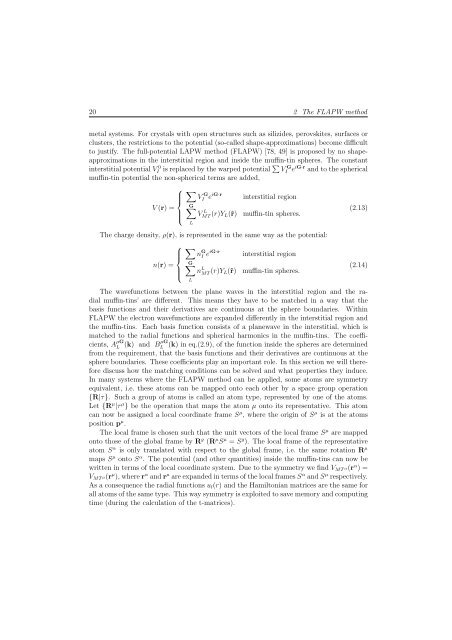Ab initio investigations of magnetic properties of ultrathin transition ...
Ab initio investigations of magnetic properties of ultrathin transition ...
Ab initio investigations of magnetic properties of ultrathin transition ...
Create successful ePaper yourself
Turn your PDF publications into a flip-book with our unique Google optimized e-Paper software.
20 2 The FLAPW method<br />
metal systems. For crystals with open structures such as silizides, perovskites, surfaces or<br />
clusters, the restrictions to the potential (so-called shape-approximations) become difficult<br />
to justify. The full-potential LAPW method (FLAPW) [78, 49] is proposed by no shape-<br />
approximations in the interstitial region and inside the muffin-tin spheres. The constant<br />
interstitial potential V 0<br />
I is replaced by the warped potential � V G<br />
I eiG·r and to the spherical<br />
muffin-tin potential the non-spherical terms are added,<br />
⎧ �<br />
⎪⎨ V<br />
G<br />
V (r) =<br />
⎪⎩<br />
G<br />
I e iG·r<br />
interstitial region<br />
�<br />
V L MT(r)YL(ˆr) muffin-tin spheres.<br />
L<br />
The charge density, ρ(r), is represented in the same way as the potential:<br />
⎧ �<br />
⎪⎨ n<br />
G<br />
n(r) =<br />
⎪⎩<br />
G I e iG·r<br />
interstitial region<br />
�<br />
n L MT(r)YL(ˆr) muffin-tin spheres.<br />
L<br />
(2.13)<br />
(2.14)<br />
The wavefunctions between the plane waves in the interstitial region and the radial<br />
muffin-tins’ are different. This means they have to be matched in a way that the<br />
basis functions and their derivatives are continuous at the sphere boundaries. Within<br />
FLAPW the electron wavefunctions are expanded differently in the interstitial region and<br />
the muffin-tins. Each basis function consists <strong>of</strong> a planewave in the interstitial, which is<br />
matched to the radial functions and spherical harmonics in the muffin-tins. The coefficients,<br />
A μG<br />
L (k) and BμG<br />
L (k) in eq.(2.9), <strong>of</strong> the function inside the spheres are determined<br />
from the requirement, that the basis functions and their derivatives are continuous at the<br />
sphere boundaries. These coefficients play an important role. In this section we will therefore<br />
discuss how the matching conditions can be solved and what <strong>properties</strong> they induce.<br />
In many systems where the FLAPW method can be applied, some atoms are symmetry<br />
equivalent, i.e. these atoms can be mapped onto each other by a space group operation<br />
{R|τ}. Such a group <strong>of</strong> atoms is called an atom type, represented by one <strong>of</strong> the atoms.<br />
Let {Rμ |τ μ } be the operation that maps the atom μ onto its representative. This atom<br />
can now be assigned a local coordinate frame Sμ , where the origin <strong>of</strong> Sμ is at the atoms<br />
position pμ .<br />
The local frame is chosen such that the unit vectors <strong>of</strong> the local frame Sμ are mapped<br />
onto those <strong>of</strong> the global frame by Rg (RμSμ = Sg ). The local frame <strong>of</strong> the representative<br />
atom Sα is only translated with respect to the global frame, i.e. the same rotation Rμ maps Sμ onto Sα . The potential (and other quantities) inside the muffin-tins can now be<br />
written in terms <strong>of</strong> the local coordinate system. Due to the symmetry we find VMTα(rα )=<br />
VMTμ(rμ ), where rα and rμ are expanded in terms <strong>of</strong> the local frames Sα and Sμ respectively.<br />
As a consequence the radial functions ul(r) and the Hamiltonian matrices are the same for<br />
all atoms <strong>of</strong> the same type. This way symmetry is exploited to save memory and computing<br />
time (during the calculation <strong>of</strong> the t-matrices).

















